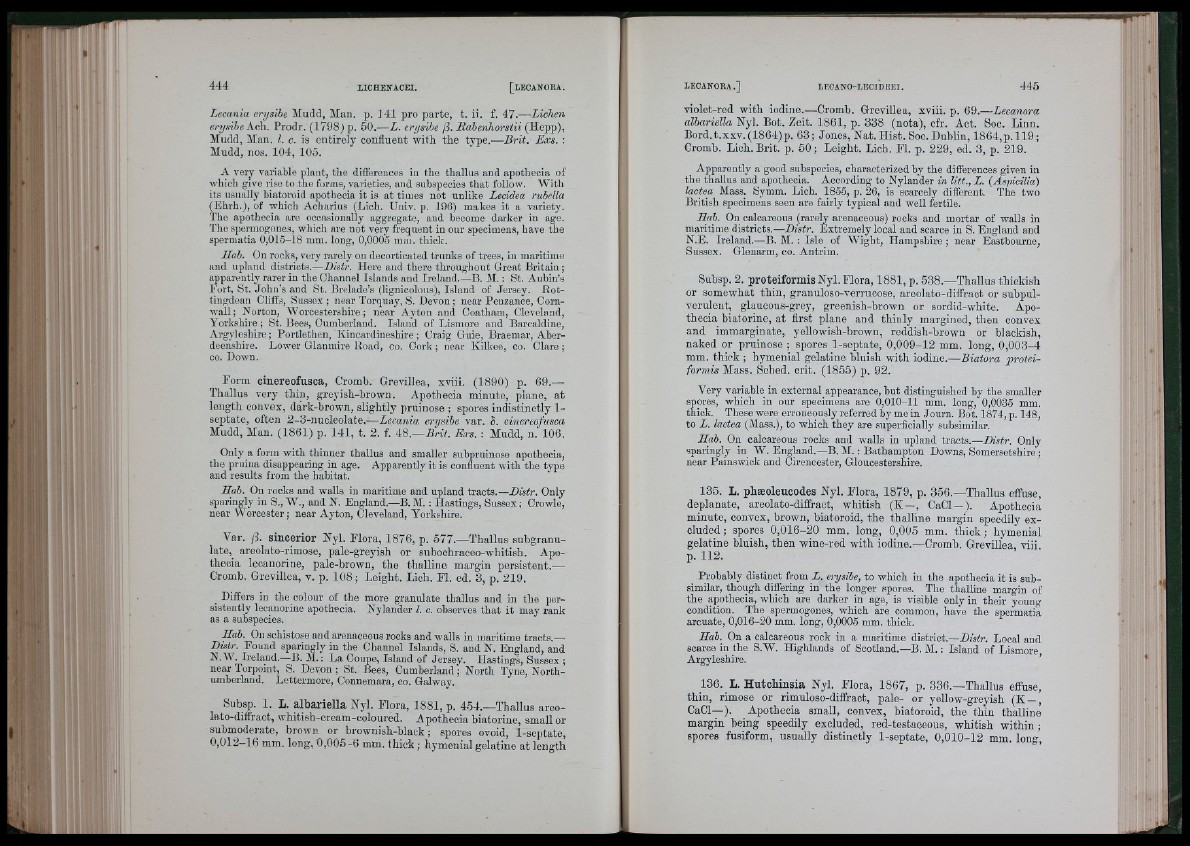
Xeranirt ei-i/si6e Mudd, Man. p. ] 41 pro parte, t. ii. f. 47 .— Lichen
erysibe ko h . Prodr. (1798) p. 50.—X. erysibe p. Rahenhorstn (Hepp),
Mudd, Man. I. c. is entirely confluent with th e type.—B r it. E.rs. :
Mudd, nos. 104, 105.
A very variable plant, the diftereiices iu the thallus and apothecia of
which give rise to the forms, vaiieties, and subspecies th at follow. With
its usually biatoroid apothecia it is at times not unlike Lecidea rubella
(Ehrh.), of which Acharius (Lich. Univ. p. 196) makes it a variety.
The apothecia are occasionally aggregate, and become darker in age.
The spermogones, which are not very frequent in our specimens, have the
spermatia 0,015-18 mm. long, 0,0005 mm. thick.
Hab. On rooks, very rarely ou decorticated trunks of trees, in maritime
and upland districts.—Distr. Here aud there throughout Great Britain;
apparently rarer in the Channel Islands and Ireland.—B. M .: St. Aubin’s
Fort, St. John’s and St. Brelade’s (lignicolous). Island of Jersey. Hot-
tingdean Cliffs, Sussex ; near Torquay, S. Devon ; near Penzance, Cornwall;
Norton, Worcestershire; near Ayton and Coatham, Cleveland,
Yorksliire; St. Bees, Cumberland. Island of Lismore and Barcaldine,
Argyleshire; Portlethen, Kincardiueshire; Craig Guie, Braemar, Aberdeenshire.
Lower Glanmlre Road, co. Cork ; near Kilkee, co. Clare ;
CO. Down.
Form cinereofiisca, Cromb. Grevillea, xviii. (1890) p. 69.—
Thallus very th in , greyish-brown. Apothecia minute, plane, a t
length convex, dark-brown, slightly pruinose ; spores indistinctly 1-
septate, often 2-3-nuoleolate.— Leeania erysibe var. ?. cinereofusca
Mudd, Man. (1861) p. 141, t. 2. f. 48.— B rit. Exs. : Mudd, n. 106.
Only a form with thinner thallus and smaller subpruinose apotbecia,
tbe pruina disappearing in age. Apparently it is confluent with the type
and results from the habitat.
Hab. Ou rocks and walls in maritime and upland tracts.—DfsZr. Only
sparingly in S., W ., and N. England.—B. M. : Hastings, Sussex; Crowle,
uear 'Worcester; near Ayton, Cleveland, Yorkshire.
Var. p. sincerior Nyl. Flora, 1876, p. 677.—Thallus subgranulate,
areolato-rimose, pale-greyish or snboohraceo-whitish. Apothecia
lecanorine, pale-brown, th e thalline margin p e rsistent.—
Cromb. Grevillea, v. p. 1 0 8 ; Leight. Lioh. Fl. ed. 3, p. 219.
Differs in the colour of the more granulate thallus and in the persistently
lecanorine apothecia. Nylander I. c. observes th at it may rank
as a subspecies.
Hab. Ou schistose and arenaceous rocks and walls in maritime tracts.—
Disir. Found sparingly iu the Channel Islands, S. and N. England, and
N.W. Ireland.—B. AI.; La Coupe, Island of Jersey. Hastings, Sussex ;
near Torpoint, S. Devon ; St. Bees, Cumberland; North Tyne, Northumberland.
Lettermore, Connemara, co. Galway.
Subsp. 1. L. albariella Nyl. Flora, 1881, p. 454.—Thallus areo-
In to-diffract, wbitish-creara-ooloured. Apotheoia biatorine, small or
submoderate, brown or brownisb-black; spores ovoid, 1-septate,
0 ,0 1 2 -1 6 mm. long, 0 ,0 0 5 -6 mm. th ic k ; bymenial gelatine a t length
violet-red with iodine.—Cromb. Grevillea, xviii. p. 69.— Lecanora
albariella Nyl. Bot. Zeit. 1861, p. 338 (nota), cfr. Act. Soo. Linn.
B o rd .t.X X V . (1 8 6 4 )p. 63 ; Jones, N a t.H is t.S o o .D u b lin , 1 8 6 4 ,p. 119;
Cromb. Liob. Brit. p. 5 0 ; Leight. Lich. Fl. p. 229, ed. 3, p. 219.
Apparently a good subspecies, characterized by the differences given in
the thallus and apothecia. According to Nylander in litt., X. {Aspicilia)
lactea Alass. Symm. Lich. 1855, p. 26, is scarcely different. The two
British specimens seen are fairly typical and well fertile.
Hab. On calcareous (rarely arenaceous) rocks and mortar of walls in
maritime districts.—Distr. Extremely local and scarce in S. England aud
N.E. Ireland.—B. M. ; Isle of Wight, Hampshire ; near Eastbourne,
Sussex. Glenarm, co. Antrim.
Subsp. 2. proteiformis Nyl. Flora, 1881, p. 538.—Thallus thickish
or somewhat th in , granuloso-verruoose, areolato-diffract or subpulverulent,
glaucous-grey, greenish-brown or sordid-white. Apothecia
biatorine, a t first plane and th in ly margined, th en convex
and immarginate, yellowish-brown, reddish-brown or blackish,
naked or pruinose ; spores 1-septate, 0 ,0 0 9 -1 2 mm. long, 0 ,0 0 3 -4
mm. thiok ; hymenial gelatine bluish with iodine.— Biatora proteiformis
Alass. Sohed. crit. (1855) p. 92.
Very variable in external appearance, but distinguished by the smaller
spores, which in our specimens are 0,010-11 mm. long, 0,0035 mm.
thick. These were erroneously referred by me in Journ. Bot. 1874,p. 148,
to X. lactea (Alass.), to which they are superficially subsimilar.
Liab. On calcareous rocks and walls in upland tracts.—Distr. Only
sparingly in W. England.—B. AI.: Bathampton Downs, Somersetshire;
near Painswick and Cirencester, Gloucestershire.
135. L. pheeoleiicodes Nyl. Flora, 1879, p. 356.—Thallus effuse,
deplanate, areolato-diffract, whitish (K —, CaCl — ). Apothecia
minute, convex, brown, biatoroid, th e th allin e margin speedily excluded
; spores 0 ,0 1 6 -2 0 mm. long, 0,005 mm. th io k ; bymenial
gelatine bluish, th en wine-red w ith iodine.—Cromb. Grevillea, viii
p. 112.
Probably distinct from X. erysibe, to which iu the apothecia it is subsimilar,
though differing in the longer spores. The thalline margin of
the apothecia, which are darker in age, is visible only in their young
condition. The spermogones, which are common, have the spermatia
arcuate, 0,016-20 mm. long, 0,0005 mm. thick.
Hab. On a calcareous rock in a maritime district.—Distr. Local and
scarce in the S.W. Highlands of Scotland.—B. AI.: Island of Lismore
Argyleshire.
136. L. Hutcbinsia Nyl. Flora, 1867, p. 336.—Thallus effuse,
tb in , rimose or rimuloso-diffract, pale- or yellow-greyish (K —,
CaC l--). Apotheoia small, convex, biatoroid, th e th in thalline
margin being speedily excluded, red-testaceous, whitish within ;
spores fusiform, usually distinotly 1-septate, 0 ,0 1 0 -1 2 mm. long,